Physical Address
304 North Cardinal St.
Dorchester Center, MA 02124
Physical Address
304 North Cardinal St.
Dorchester Center, MA 02124

Enveloped in a veil of lush greenery, teeming with unique wildlife and echoing with the symphony of nature, the Australian rainforests are a world within themselves. They are home to an astounding array of flora and fauna, many of which cannot be found anywhere else on Earth. These ancient forests harbour secrets that have stood the test of time, waiting to be discovered by intrepid explorers.
Australia’s rainforests stretch from the tropical north down to the temperate south. The Daintree Rainforest in Queensland is arguably one of Australia’s most famous rainforests. It is recognised as the oldest continuously surviving tropical rainforest in the world, dating back over 135 million years. Its age-old trees stand tall like sentinels guarding secrets that date back to prehistoric times.
In contrast, Tasmania’s Tarkine Rainforest offers a cooler climate but no less enchanting experience. This temperate rainforest is part of one of the world’s last untouched wilderness areas, offering pristine landscapes and unique wildlife.
The Australian rainforests present an unparalleled diversity in plant life. The verdant canopy is primarily made up of evergreen trees such as figs and eucalypts interspersed with palms and ferns. The understory thrives with shrubs, mosses and lichens, creating a multi-layered tapestry that supports numerous ecosystems.
The Daintree Rainforest alone houses around 3,000 species of plants. Among them are some rare gems such as Idiospermum australiense or ‘Idiot Fruit’, one of Earth’s most primitive flowering plants, and the endangered Southern Yew, a relic from bygone eras.
The Australian rainforests are a hub of biodiversity. They provide habitats for a multitude of species, many of which are endemic to Australia. From the iconic koala and kangaroo to the elusive platypus and Tasmanian devil, these forests are teeming with life.
However, it’s not just about mammals. The rainforest is also home to an array of birds like the colourful parrots and cockatoos, amphibians such as the unique gastric-brooding frog, reptiles including the prehistoric-looking frilled-neck lizard, and countless species of insects and arachnids.
The Australian rainforests hold profound significance for Indigenous Australians. For tens of thousands of years, these forests have provided food, shelter, medicine and spiritual connection. Many sacred sites dotting the landscape bear testament to their rich cultural heritage.
Indigenous knowledge systems offer invaluable insights into sustainable forest management practices that have preserved these ecosystems for millennia. Their stories passed down through generations weave a rich tapestry that intertwines humans with nature in a complex web of interdependence.
Despite their ecological importance, Australian rainforests face numerous threats ranging from deforestation and climate change to invasive species and diseases. These factors have led to habitat loss and fragmentation, posing serious challenges for wildlife conservation.
In response to these threats, various conservation initiatives are underway across Australia. Protected areas such as national parks play a crucial role in preserving biodiversity hotspots. Meanwhile, reforestation projects aim at restoring degraded landscapes while community education programs strive to raise awareness about the importance of these ecosystems.
Scientific research is also vital in understanding and mitigating the impacts of climate change on rainforest ecosystems. Through studying tree rings, scientists can uncover historical climate patterns and predict future trends, informing adaptive management strategies.
The Australian rainforests are a treasure trove of biodiversity, cultural heritage and ecological services. As we delve deeper into their secrets, it becomes increasingly clear that preserving these ancient forests is not just about protecting nature – it’s about safeguarding our shared future.